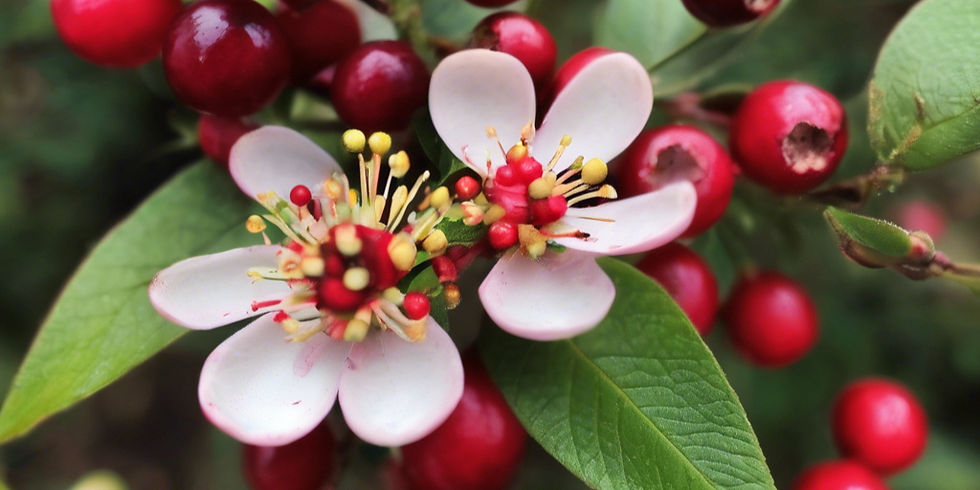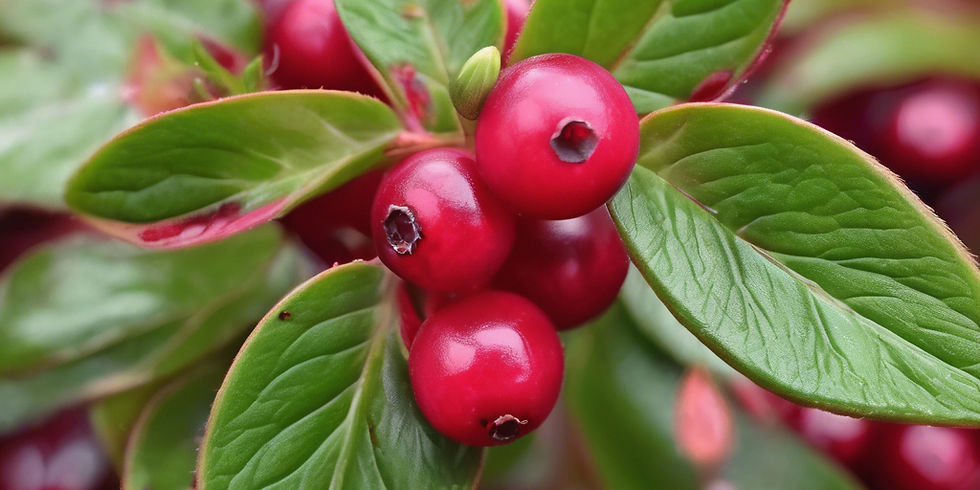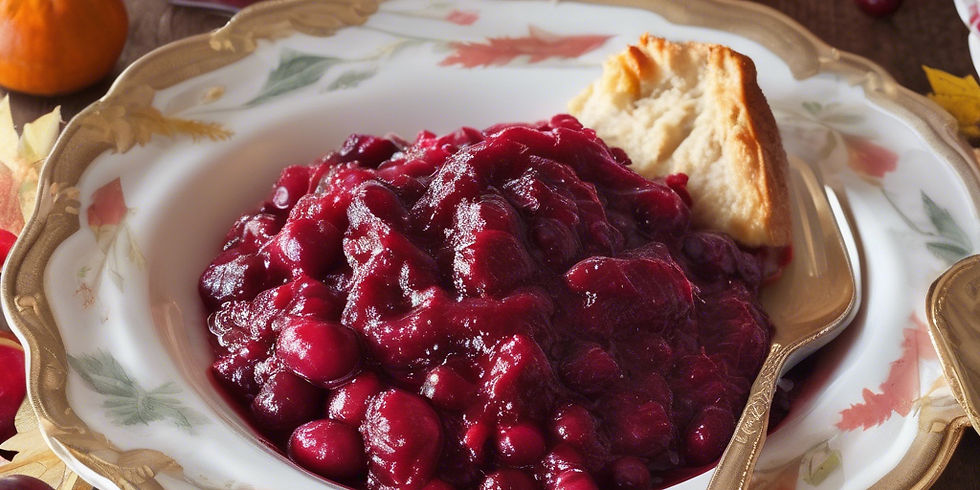Cranberry
- The Economic Botanist

- Mar 9
- 8 min read
Scientific Name: Vaccinium macrocarpon Aiton
Family: Ericaceae

The cranberry is a small, tart fruit widely recognized for its vibrant red colour and distinctive sour taste. Native to North America, cranberries have been a staple in both the diets and medicinal practices of indigenous peoples for centuries. Over time, the fruit has become a prominent part of modern culinary traditions, especially in Thanksgiving dishes, juices, and sauces. Additionally, cranberries have earned a reputation for their impressive health benefits, particularly in promoting urinary tract health and fighting off infections.
Cranberries are a unique and versatile fruit that is celebrated not only for its tangy taste but also for its nutritional content, which includes high levels of antioxidants, vitamins, and other bioactive compounds. Whether enjoyed in sweet desserts, savory dishes, or as a refreshing beverage, cranberries continue to capture the interest of chefs and health-conscious individuals worldwide.
History of Cranberry
Cranberries have a long and rich history, particularly in North America. Indigenous tribes, such as the Algonquin and Wampanoag, were the first to use cranberries for both food and medicinal purposes. The fruit was often dried and mixed with other ingredients to create "pemmican," a high-energy food made from dried meats and berries that would sustain people during long winters. Cranberry juice, too, was used as a remedy for various ailments, and the berries were believed to have healing properties for wounds, infections, and digestive issues.
The commercial cultivation of cranberries began in the early 19th century. Initially, the berries were harvested from wild plants, but over time, methods for cultivating cranberries on farms were developed. Today, cranberry production is a major agricultural industry, particularly in states like Wisconsin, Massachusetts, and New Jersey. In fact, the United States is the largest producer of cranberries in the world.
Botanical Description
Cranberries are low-growing, evergreen shrubs that are native to the cooler regions of North America. These shrubs typically reach a height of 6–8 inches (15–20 cm) and spread out to form a dense ground cover. The plant has small, leathery, evergreen leaves that remain green throughout the year. In late spring to early summer, cranberries produce small, pinkish or white bell-shaped flowers, which eventually give way to the fruit.
The cranberries themselves are small, round berries, typically about 1–2 cm in diameter. They start off green, gradually turning white and finally reaching their signature deep red color when ripe. These berries grow in clusters and are harvested in the fall, often after the first frost, which helps enhance their flavor.
Cranberries are typically grown in boggy, acidic soil in areas with cool temperatures and abundant water. These conditions are ideal for cultivating cranberries, as they thrive in wetland environments where they are able to access the necessary nutrients and moisture.

Growing Instructions
Cranberries require specific growing conditions to thrive. Successful cultivation of cranberry plants involves understanding their environmental needs and providing the proper care throughout the growing season.
Sunlight: Cranberries require full sunlight to grow properly, although they can tolerate some light shade. Ideally, the plants should receive at least 6–8 hours of direct sunlight each day to produce healthy berries.
Soil: Cranberries grow best in acidic, well-drained soils with a pH between 4.5 and 5.5. The soil should also be rich in organic matter, as cranberries benefit from nutrients provided by decomposing plant matter. It's crucial to maintain good drainage, as cranberries do not like waterlogged soil, despite their preference for moist conditions.
Temperature: Cranberries thrive in temperate climates with cool to moderate temperatures. They are hardy plants that can withstand winter frost, which helps enhance their flavor. However, they do best in regions with mild winters and cool summers. Cranberries can tolerate temperatures down to around -10°F (-23°C) once they are fully established.
Watering: Cranberries require consistently moist conditions, especially during the growing season. In natural bog environments, they are often submerged in water for part of the year. For cultivated cranberries, regular irrigation is important to ensure the plants do not dry out. However, the soil must have good drainage to prevent the roots from becoming waterlogged.
Spacing: When planting cranberries, it's important to provide enough space for the plants to spread. A spacing of 12–18 inches (30–45 cm) between plants is ideal to allow for healthy growth and air circulation. Rows should be spaced about 3–4 feet (1–1.2 meters) apart to give each plant enough room to grow.
Pruning: Pruning is essential for maintaining healthy cranberry plants. In early spring, remove any dead or damaged wood, and trim back older stems that are no longer productive. This encourages the growth of new, productive shoots. Proper pruning also helps improve air circulation and reduces the risk of disease.
Support: While cranberry plants do not require support structures like vines, they may benefit from the use of a trellis or low fencing in areas with strong winds, as the berries can be quite heavy and may cause the branches to droop. For the most part, cranberries grow well without additional structural support.
Life Cycle: Cranberries are perennial plants, meaning they live for many years and continue to produce fruit year after year. Here’s an overview of their life cycle:
Germination: Cranberry seeds can take several months to germinate, typically requiring cold stratification (exposure to cold temperatures) before they will sprout. However, most commercial growers propagate cranberries through cuttings or clones, rather than starting from seed.
Vegetative Growth: After germination, cranberry plants grow slowly, producing small, leathery leaves and forming ground-covering stems. This phase typically lasts for a couple of years before the plants begin to produce significant fruit.
Flowering: Cranberries bloom in late spring to early summer, with the flowers developing into small, bell-shaped blossoms. These flowers are pollinated by bees, and the presence of pollinators is crucial for successful fruiting.
Fruit Set: By late summer to early fall, cranberry plants produce small, green berries that eventually ripen to a deep red color. Cranberries are typically harvested in the fall, when they have reached their peak ripeness.
End of Season: Cranberry plants enter a period of dormancy in the winter months. As evergreen plants, their foliage remains green through the winter, and they can withstand cold temperatures and snow. During this time, the plant’s growth slows down, and it begins to prepare for the next growing season.
Harvesting and Foraging
Harvesting: Cranberries are usually harvested once they have reached full ripeness, typically in late September to early November. In commercial operations, cranberries are often harvested by flooding the bogs, causing the berries to float to the surface where they can be easily collected. For home gardeners, cranberries can be hand-harvested or gathered with a rake designed for berry picking.
Foraging: Wild cranberries can be foraged from boggy areas, particularly in the northern United States and Canada. When foraging, it's important to check local regulations and ensure that you are harvesting from public land or areas where foraging is permitted. Be sure to avoid overharvesting, as cranberry plants take time to regenerate and produce fruit.

Plant Companions
Cranberries grow well in association with other plants that thrive in acidic, moist soils. Suitable plant companions include:
Blueberries: Both blueberries and cranberries have similar growing requirements, including acidic soil and abundant moisture.
Bog Plants: Plants like sphagnum moss, ferns, and certain grasses are often found in the same boggy environments where cranberries grow.
Huckleberries: These berries share similar environmental preferences and can be grown alongside cranberries.
Common Pests and Diseases
Pests: Cranberries are vulnerable to a number of pests, including:
Cranberry Weevil: This pest feeds on developing cranberry fruit, causing damage to the berries.
Leafroller Moths: The larvae of these moths can cause damage to cranberry plants by feeding on the leaves and stems.
Aphids: Aphids can weaken cranberry plants by feeding on their sap, leading to reduced growth and potential disease transmission.
Diseases: Cranberries are also susceptible to several diseases, such as:
Cranberry Fruit Rot: This fungal disease affects the berries, causing them to rot. It is often caused by high humidity and poor air circulation.
Cercospora Leaf Spot: A fungal disease that causes brown or gray lesions on cranberry leaves.
Phytophthora Root Rot: Caused by a soil-borne pathogen, this disease affects the roots of cranberry plants, especially in waterlogged conditions.
Shopping Tips
When purchasing cranberries, look for firm, plump berries with a bright red color. Avoid berries that are soft, shriveled, or have signs of mold. Fresh cranberries are often sold in bags or plastic containers. If purchasing cranberry products, such as juice or sauce, check the ingredient label to ensure they contain a high percentage of cranberry and minimal added sugars or preservatives.
Storage
Fresh cranberries should be stored in the refrigerator, where they will last for up to a month. If you have an abundance of cranberries, you can freeze them by spreading the berries out on a baking sheet and freezing them before transferring them to a storage container. This method prevents the berries from clumping together and makes it easier to portion them out as needed.
Food Safety
Cranberries are safe to eat raw, but their tartness may be too intense for some. When consuming raw cranberries, be sure to rinse them thoroughly to remove any dirt or pesticides. Cranberry products, such as juices or sauces, should be checked for added sugars, which may impact their overall health benefits.
Culinary Uses
Cranberries are incredibly versatile in the kitchen and can be used in a wide range of dishes, from sweet desserts to savory meals. Some popular culinary uses for cranberries include:
Cranberry Sauce: A classic accompaniment to turkey and other holiday dishes.
Baked Goods: Cranberries are commonly used in muffins, breads, pies, and tarts, adding a burst of color and tartness to sweet baked goods.
Smoothies: Cranberries can be blended into smoothies for a refreshing, antioxidant-packed beverage.
Juices and Beverages: Cranberry juice is a popular drink, known for its tart flavor and health benefits.
Salads: Dried cranberries make a delicious addition to salads, providing a sweet contrast to greens and nuts.

Health Benefits
Cranberries offer a variety of health benefits, largely due to their high levels of antioxidants, vitamins, and other bioactive compounds. Some key health benefits of cranberries include:
Urinary Tract Health: Cranberries are widely known for their ability to prevent urinary tract infections (UTIs). The active compounds in cranberries prevent harmful bacteria from adhering to the walls of the urinary tract, reducing the risk of infection.
Antioxidant Properties: Cranberries are rich in antioxidants like flavonoids and anthocyanins, which help protect the body from oxidative stress and free radical damage.
Heart Health: Cranberries have been shown to help improve cholesterol levels and reduce the risk of cardiovascular disease by lowering LDL (bad) cholesterol and raising HDL (good) cholesterol.
Anti-inflammatory Effects: The compounds in cranberries may help reduce inflammation, which can benefit those with inflammatory conditions like arthritis.
Digestive Health: Cranberries are a good source of fiber, which supports digestive health and helps regulate bowel movements.
Toxicity and Safety
Cranberries are generally considered safe for most people. However, excessive consumption of cranberry juice or supplements can cause mild digestive upset. Cranberry juice is also high in natural sugars, so it should be consumed in moderation, especially for those with diabetes.
Environmental Impact
Cranberries are typically grown in boggy, wetland areas, which are important ecosystems that support diverse plant and animal life. Sustainable cranberry farming practices can help preserve these wetlands and protect biodiversity. However, large-scale cranberry farming can pose environmental challenges, including water use and pesticide runoff, which is why it's important to support sustainably grown cranberry products.




Comments